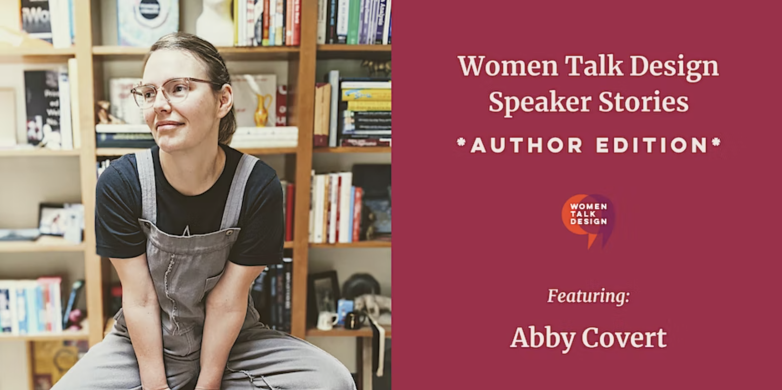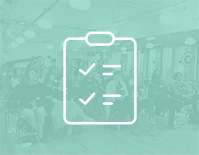Abby Covert on the importance of knowing yourself
As part of our #WTDSpeakerStories, we spoke with Abby Covert about her experiences as a teacher, speaker and writer and the lessons she’s learned–mainly to stay true to what matters most to you, finding your own meaning, motivation, and processes.
In our Women Talk Design Speaker Stories series, we’re interviewing Women Talk Design speakers about their journeys and experiences. We talk to speakers who are just getting started, speakers who have had their fair share of speaking mishaps, speakers writing books, and speakers curating events. At the end, we offer an opportunity for folks from the WTD community to ask their own questions and connect with each other. Visit our events page for more information about the series and RSVP for our next event.

Abby Covert is an information architect, writer, and community organizer with two decades of experience helping people make sense of messes. In addition to being an active mentor to those new to sense-making, she has also served the design community as President of the Information Architecture Institute, co-chair of the Information Architecture Summit, and Executive Producer of the I.D.E.A Conference.
Abby is a founding faculty member of the School of Visual Arts Products of Design graduate program. She also managed the team that helped Rosenfeld Media to start both the Design Operations Summit and Advancing Research Conference. Her most proud achievement is having come up with the idea for World Information Architecture Day, bringing accessibly-priced education to thousands in their local communities annually.
Abby has written two books for her students. In 2014 she published How to Make Sense of Any Mess, a book to teach IA to everybody. In 2022, she released her much-anticipated follow-up, Stuck? Diagrams Help. She currently spends her time making things that help you to make the unclear, clear, many of which she makes available for free on her website or at accessible price points in her popular Etsy shop AbbytheIA.
Abby lives and writes from Melbourne, Florida where her most important job title is ‘Mom’.
On how she started speaking
Abby discussed how her beginnings as a speaker stemmed from two experiences – first, an early love for musical theater, and second, her encounters as an event producer.
“I feel like I came full circle on the speaking thing. The background that I have primarily in speaking comes from an interest in musical theater. When I was in grade school, I was in my first theatrical production and I really fell in love with entertaining an audience. By the time I graduated from high school, I had kind of figured out that that wasn’t going to be a career for me and I was willing to put it up on the shelf.”
“I went to school in undergrad for graphic design and eventually entered into a multimedia studies program. Coming out of that program, I never really expected that my theatrical skills would apply to this newfound career path as an information architect. But, as I got into the community and realized that there was a need for event producers, I was introduced to this whole world of people who were presenting about their work and doing it in entertaining and educational and fun ways at these annual conferences.”
“The first step that I took was volunteering for those conferences. Through [that], I got exposed to a lot of people, and many of them started to encourage me to submit my own ideas for talks and also to start writing. So my blog, AbbytheIA, started much before my speaking career in this industry began.”
“I started with a lightning talk that was done through an agency that I worked with. That was my very first [talk], and I won the speaking competition at that agency so they sent me to a national conference to go away for a week and get educated–not be working at the conference. That was kind of the beginning of me thinking, ‘I like this, I feel like I can contribute a unique perspective to the industry that I’m in.’”
She goes on to talk about how her motivation to speak came from a love of what she did and that she felt creating content for future generations to access, the same way others had helped her, was a “worthy cause”.
“I really like my work and I feel it’s hard–some of this work is really hard–and the people that helped me when I was all by myself in a cubicle, trying to figure out how to do my first site audit or my first heuristic evaluation, were out there, giving their content away and building these content universes so that future generations could have access to. I just thought that was such a worthy cause to put my time into. Now, we’re like a decade and a half later, and I’m still doing talks.
Abby also highlighted how her approach to speaking evolved as she found herself through her own focus on the message and audience.
“I had a period early in my speaking career where I really forced myself to take theatrical standards to it–be off book and be blocked. I had all these tools that I wanted to apply. But honestly, I found that the effort that you put into that stuff wasn’t really rewarded by more reception from an audience. The time was better spent in the creation of ideas and formulation of those ideas into multiple mediums, whether that be short talks, long talks, blog posts, tweets, whatever kind of media makes sense for the message.”
“That’s where I’m at now–trying to figure out who are the audiences that I want to reach with my message and what are the right mediums to do that.
On writing her first (and second) book
When discussing writing her first book, Abby talked about the ways she approached choosing her topic and developing the book, focusing on her audience.
“To describe the last 6 months of that book process as a ‘fever dream’ would be pretty accurate. I took 18 months to write my first book. It’s a really short book, so that says a lot about how much I hemmed and hawed about its structure. I think, ultimately, all of that came back to my readers in terms of clarity so I’m happy to have given it that.”
“The biggest decision that I made in writing that book was to take a risk on myself–to really invest in publishing it myself. In 2014, when I first started writing the book, was a time when everyone was trying to figure out how information architectures still fit into the UX industry. There was a lot of encouragement for me to write a book about information architecture for websites, mobile applications, social media platforms, and to be very specific about the medium. I did not want to do that. That was not going to last the test of time. At that point I was about a decade into my own career and I’d already seen all of the technology change 3 times. So I was like, ‘There’s something about information architecture that predates my time and tech, that goes all the way back to a basic understanding of how to arrange things to make a message clear to a person.’ And I felt like that book needed to exist.”
“I also was at this weird spot that a lot of people experience where they decide to teach and then have to find the materials that they want to teach from. When I looked at the information architecture materials that were out there, they were fabulous for practitioners. But, when you had art school students, getting them to read a 400 page book about information architecture was not going to happen.
“I started to write a book about information architecture for my students, then I delivered them a chapter every single week for the entire semester. That is not the book that I ended up publishing to the public but it is the first version of [deciding], ‘Yeah, I do have an entire book worth of stuff to say here and there is value in breaking this concept down for this kind of more general audience.’”
On how she feels about marketing herself
Abby explained her feelings about self-promotion and the struggles she feels with marketing as she aims to connect most directly with her audience.
“I am currently battling a mental monster of feeling like I’m not allowed to market my own work and feeling very challenged about the velocity of marketing that is required to play with the systems that we are given.”
“Social media, for example–if I want to be marketing on social media at all, I have to be putting in a tremendous amount of effort, because if I only go on there once a week, or once a month, or once a quarter and say something, it is literally like walking into a very crowded room, screaming and running out. And I know that. But to take the time to play the game to get valued by the system, and not by my readers–that doesn’t feel authentic to me.”
When it came to marketing, Abby said she chose to focus solely on email to allow herself the distance and relationship she needed to have with her audience.
“That becomes the question: What is the most direct way that I can reach my customer? At this moment, in this reality, it happens to be email. So in 2020 I shifted my focus entirely to building my mailing list. That’s all I ever marketed– I just said that if you want to know anything from me, this is where I’m doing it.”
“I’m not on social media right now. I don’t know if that’s a good marketing move. But, [I needed] to get distance from the idea of marketing myself all the time, while also simultaneously writing a book (that I wasn’t sure how it was gonna go or where it was gonna go or what it was gonna end up being). That gave me a lot of space. I had a social contract with my audience that if they didn’t hear from me for a couple of months, they were probably going to reach out and say something. And they did.”
Abby also explored the “existential creator dilemma” she’s felt as someone who is wants to create the work she is invested in but felt uncomfortable telling people what she was doing.
“I managed to get 10 emails sent last year. I promised one a month [but] I did not get one a month out. You might be like, ‘Oh, you were super busy. You didn’t get around to writing it.’ No, no, no, no. This email was in the email software, it was formatted, it was scheduled, it was ready to go. Why did it not send? Because of fear. [Because of] me not thinking that I’m enough to have that space in somebody else’s inbox and somebody else’s life.”
“Those 2 emails taught me a lot about myself as a creator. It became a kind of existential creator dilemma. I really want to do this–I want this to be what I’m putting all of my time into professionally. But if I’m going to do that, I need to be comfortable with telling people what I’m doing.”
“The big move that I made after the book came out was that I set some sales goals and I said, ‘If I can hit these numbers by this date, I’m going to hire myself a producer.’ Because then I would have this other person I have to report to about sending emails and actually going on social media. I am currently 3 months into having a producer on my team, which is really cool and it’s taken some of that pressure away but not all of it.”
The advice Abby shared for others with similar experience was to focus on those who matter and do what is right for you, not just what you “should” be doing.
“For other people that are in a similar space–having to speak about yourself to your audience–I’ll give you the advice that all of my loved ones gave me while I was going through it. One, they opted into hearing from you. They want to hear from you. Period. And two, some people hate the Beatles. There are going to be people that don’t like what you have to say. There are going to be people that don’t like the way that you wrote the tweet that you sent or whatever and that’s going to continue to be the case. Have the resilience to know whose opinion you care about and whose opinion you can let go of and rely on your actual values to decide how you’re going to market yourself, not the ‘supposed to’. I don’t think that stuff actually works. I think that our audiences can see it through it.”
On balancing creativity and process
When asked about how Abby balances her creativity with the need for a more strategic process, she talked about knowing when to be flexible and when to count on habit and routine.
“One of the things that I do for myself is I spend a lot of time upfront when I’m working on a project being really divergent about what it is I’m making. I try to keep that a pretty flexible medium. I love doing things by hand, I’m a big journaler. I find that if you do all that, you can make yourself a map that you write linearly to. That’s where your habit and your routines become the thing that takes you through the rest of the process.”
“You can’t be creative all the way through. If you’re creative all the way through, you’ll keep changing your mind. You’re gonna keep throwing in new things. There has to be a point where you say, ‘This is the book. I’m gonna go this way.’ You’re still gonna change your mind about things but at least you have a plan.”
“Then it’s about showing up. For me, that meant picking a time of day literally every single day that where I showed up and I picked up in the middle of a sentence–that’s a good trick if you’ve never heard that one. ‘Where was I? Where did I finish yesterday?’ I have a word count or a time goal. I set a timer for 2 hours but I also tried to hit 1,000 words. Sometimes, I’d hit a 1,000 words in half an hour and go on with my day. Other times, it’s like 2 hours in, I have not hit 1,000 words, I feel like absolute death, and I stop because the timer goes off. And I’ll try again tomorrow.”
Abby also highlighted the importance of knowing yourself as a creator and surrounding yourself with others who can help in your process.
“I’ve been in therapy for many, many years and my therapist really helped during this process when a crisis of confidence would come up for me. When those things were happening, even when I was able to drag myself to my desk and show up for those times, that turned into beating myself up.
“The best answer is to start to know yourself as a writer. When you say it gets hard, what does that mean [for you?] Is it that you’re tired of writing, you’re exhausted from the process? Maybe you need a couple of days off. Versus if you don’t think that you’re writing the book you want to write, which is a completely different crisis to have. Know yourself enough to know what you need and then, have your arsenal of people that you can go to for those types of things like.”
“There was one point in this book pretty late in the game where I was having a real crisis about the length of it. I called the head of the Products of Design Department, who helped me with my first book in a similar position of crisis of confidence, and I was just like, ‘You read this thing like, Is it too long? Does it have too much?’ And we just went around the carousel a couple of times. Find people that are willing to go on the carousel ride with you. He didn’t say, ‘Here’s what you need to do.’ He was like, ‘Okay, let’s go around it again. Do you think it is okay? What are you thinking?’”
You need people that will allow you to voice your concerns about your work and will take you seriously about it cause writing is a really lonely place. Get you some writing friends and some creative muses in your arsenal.”
For more on how Abby balances creativity and strategy, the writers and speakers who inspire her, and her amazing bookshelves, check out the full video below.

